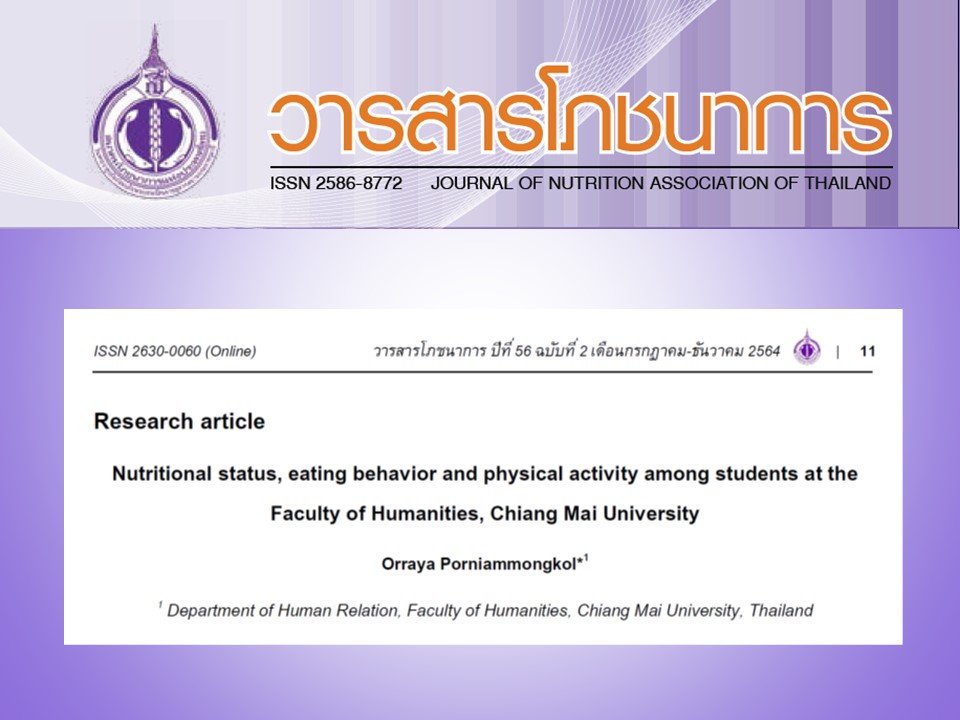Nutritional Status, Eating Behavior and Physical Activity among Students at the Faculty of Humanities, Chiang Mai University
Keywords:
Food consumption behavior, Body Mass Index, Energy intake, Obesity, Undergraduate studentsAbstract
This research aimed to evaluate nutritional status, eating behaviors and physical activities among undergraduate students of Faculty of Humanities, Chiang Mai University. This is a cross-sectional study using a convenient sample by public announcement for volunteers. Four hundred students, 26.2% males and 73.8% females, were included in the study. Nutritional status was assessed by body mass index (BMI) using Asian adult criteria for nutritional status classification. Eating behavior and lifestyle physical activities were assessed using questionnaires and evaluated by rating scales of 4 points Likert Scale (1=need improvement to 4=very good). Energy intake of the students were assessed by one-day 24 hours dietary recall and energy intake calculated using INMUCAL-Nutrients V. 3.0 Program. The results revealed that overweight (BMI 23.0-24.9), obese I (BMI 25.0-29.9) and obese II (BMI > 30) were 14, 7 and 3 %, respectively. Overweight and obesity were greater among males (38%) than that of females (20%), whereas less underweight among males (16.2%) than females 24.1 (p <.001). Overall mean energy intake was 1,250+748 kcal per day and not significantly different between males and females. Overall average scores on eating behaviors and lifestyle activities were considered good (2.61±0.24 and 2.79±0.32, respectively). Among the eating behavior or physical activity which the average scores were good, for some behaviors, more than 50% of students were below the acceptable scores. Obese group (BMI>30 kg/m2) had significantly lower scores on eating more at dinner than lunch/ breakfast, and spending over 2 hours per day on computer game compared with other BMI groups (p<0.01 and p<0.05, respectively).
References
Hill JO, Wyatt HR and Peters JC. Energy balance and obesity [Internet]. 2012 [Cited 2019 June 20]. Available from: https://www.ncbi.nlm.nih.gov/pmc/articles/PMC3401553/
วิชัย เอกพลากร และคณะ. การสำรวจสุขภาพประชาชนไทยโดยการตรวจร่างกายครั้งที่ 5 พ.ศ.2557. กรุงเทพฯ: สถาบันวิจัยระบบสาธารณสุข (สวรส.); 2559.
สำนักงานสถิติแห่งชาติ. การสำรวจพฤติกรรมการบริโภคอาหารของประชากร พ.ศ. 2556. กรุงเทพฯ : กองสถิติพยากรณ์ สํานักงานสถิติแห่งชาติ; 2557.
ตวงพร กตัญญุตานนท์. ภาวะโภชนาการและพฤติกรรม 3 อ.ของนักศึกษาชั้นปีที่1 มหาวิทยาลัยหัวเฉียวเฉลิมพระเกียรติ. มฉก.วิชาการ 2554; 14(28):67-8.
Xue H, Tian G, Duan R, Quan L, Zhao L, Yang M, et.al. Sedentary behavior is independently related to fat mass among children and adolescents in South China. Nutrients 2016; 8:667.
Grontved A, Ried-Larsen M, Moller NC, Kristensen PL, Wedderkopp N, Froberg K, et al. Youth screen-time behaviour is associated with cardiovascular risk in young adulthood: The European Youth Heart Study. Eur J Prev Cardiol 2014; 21(1):49-56.
Yamane, Taro. Statistics: An introductory analysis. 2nd edition. New York: Harper and Row; 1973.
World Health Organization, Western Pacific Regional. The Asia-Pacific perspective: redefining obesity and its treatment. Sydney: Health Communications Australia [Internet]. 2000 [Cited 2019 June 20]. Available from: https://apps.who.int/iris/handle/10665/206936
ซิ่วฮวย แซ่ลิ้ม กนกพร หมู่พยัคฆ์ และนันทวัน สุวรรณรูป. ปัจจัยที่มีความสัมพันธ์กับพฤติกรรมการดื่มเครื่องดื่มแอลกอฮอล์ของวัยรุ่น. พยาบาลสงขลานครินทร์. 2560; 37(3):25-36.
รัตติยา บัวสอน และ เชษฐ รัชดาพรรณาธิกุล. พฤติกรรมการบริโภคเครื่องดื่มแอลกอฮอล์ของนักศึกษามหาวิทยาลัยระดับปริญญาตรีในเขตกรุงเทพมหานคร. รามาธิบดีพยาบาลสาร 2555; 18(2):259-71.
อัมมันดา ไชยกาญจน์ และ อมรา ไชยกาญจน์. พฤติกรรมการดื่มเครื่องดื่มแอลกอฮอล์ของนักศึกษามหาวิทยาลัยราชภัฏพระนครศรีอยุธยา จังหวัดพระนครศรีอยุธยา. วไลยอลงกรณ์ปริทัศน์(มนุษยศาสตร์และสังคมศาสตร์) 2560; 7(1):103-13.
สำนักยุทธศาสตร์ งานพัฒนาธุรกรรมทางอิเล็กทรอนิกส์ กระทรวงดิจิทัลเพื่อเศรษฐกิจและสังคม. รายงานผลการสำรวจพฤติกรรมผู้ใช้อินเทอร์เน็ตในประเทศไทย ปี 2563. [อินเตอร์เน็ต]. 2561 [เข้าถึงเมื่อ 1 เม.ย. 2564] ; เข้าถึงได้จาก:
https://www.etda.or.th/th/Useful-Resource/publications/Thailand-Internet-User-Behavior-2020.aspx
วรรณภา เล็กอุทัย ลี่ลี อิงศรีสว่าง เนติ สุขสมบูรณ์ และ ยศ ตีระวัฒนานนท์. ปัจจัยที่มีผลต่อการเกิดโรคอ้วนของนักศึกษาระดับปริญญาตรีในจังหวัดเชียงใหม่. วิจัยระบบสาธารณสุข 2554; 5(3):299-306.
มโนลี ศรีเปารยะ เพ็ญพงษ์. พฤติกรรมการบริโภคอาหารของกลุ่มนักเรียนและนักศึกษาในจังหวัดสุราษฎร์ธานี.วารสารวิทยาการจัดการ มหาวิทยาลัยราชภัฏสุราษฎร์ธานี 2559; 3(1):109-26.
สิริไพศาล ยิ้มประเสริฐ. พฤติกรรมการบริโภคอาหารของนักศึกษา ระดับปริญญาตรี ชั้นปีที่ 1 มหาวิทยาลัยเทคโนโลยีราชมงคลอีสาน นครราชสีมา. วารสารราชพฤกษ์ 2560; 15(1):33-41.
ฉัตรฤดี สุบรรณ ณ อยุธยา และ พรพิไล เติมสินสวัสดิ์. ภาวะน้ำหนักเกินโภชนาการของนักศึกษาและบุคลากร ในมหาวิทยาลัยราชมงคลพระนคร. รายงานสืบเนื่อง การประชุมวิชาการมหาวิทยาลัยราชมงคล ครั้งที่ 9 “ราชมงคลสร้างสรรค์กับนวัตกรรมที่ยั่งยืนสู่ประเทศไทย 4.0” 2559. [เข้าถึงเมื่อ 11 ก.ค. 2562] เข้าถึงได้จาก: https://repository.rmutr.ac.th/bitstream/handle/123456789/684/rmutrconth_38.pdf?sequence=1&isAllowed=y
สำนักงานสถิติแห่งชาติ. การสำรวจพฤติกรรมการบริโภคอาหารของประชากร. พ.ศ. 2560. กรุงเทพฯ : กองสถิติพยากรณ์ สํานักงานสถิติแห่งชาติ; 2560.
วิชัย เอกพลากร และคณะ. การสำรวจสุขภาพประชาชนไทยโดยการตรวจร่างกายครั้งที่ 4 พ.ศ.2551-52. กรุงเทพฯ: สำนักงานสำรวจสุขภาพประชาชนไทย สถาบันวิจัยระบบสาธารณสุข (สวรส.); 2554.
สถาบันวิจัยประชากรและสังคม มหาวิทยาลัยมหิดล ร่วมกับ ส านักงานกองทุนสนับสนุนการสร้างเสริมสุขภาพ (สสส.). สถานการณ์ด้านการมีกิจกรรมทางกายของคนไทย ระหว่าง พ.ศ. 2555-57 [อินเทอร์เน็ต]. [เข้าถึงเมื่อ 14 มี.ค. 2564]. เข้าถึงได้จาก: http://padatabase.net/uploads/files/12/doc/369_55-57.pdf
De Vries JH, Zock PL, Mensink RP, Katan MB. Underestimation of energy intake by 3-d records compared with energy intake to maintain body weight in 269 nonobese adults. Am J Clin Nutr 1994; 60(6):855–60.
Goris AH, Westerterp-Plantenga MS, Westerterp KR. Undereating and under recording of habitual food intake in obese men: selective underreporting of fat intake. Am J Clin Nutr 2000; 71(1):130-4.
Jonnalagadda SS, Mitchell DC, Smiciklas-Wright H, Meaker KB, Van Heel N, Karmally W, et al., Accuracy of energy intake data estimated by a multiple-pass, 24-hour dietary recall technique. J Am Diet Assoc 2000; 100(1):303-8.
Poslusna K, Ruprich J, de Vries JHM, Jakubikova M and Veer PV. Misreporting of energy and micronutrient intake estimated by food records and 24 hour recalls, control and adjustment methods in practice. Br J Nutr 2009; 101(Suppl. 2):S73–85.
Kye S, Kwon SO, Lee SY, Lee J, Kim BH, Suh HJ and Moon HK. Under-reporting of energy Intake from 24-hour dietary recalls in the Korean National Health and Nutrition Examination Survey. Osong Public Health Res Perspect 2014; 5(2):85-91.
Shi H and Clegg DJ. Sex Differences in the regulation of body weight. Physiol Behav. 2009; 97(2):199–204.

Downloads
Published
How to Cite
Issue
Section
License
Upon acceptance of an article, copyright is belonging to the Nutrition Association of Thailand.


